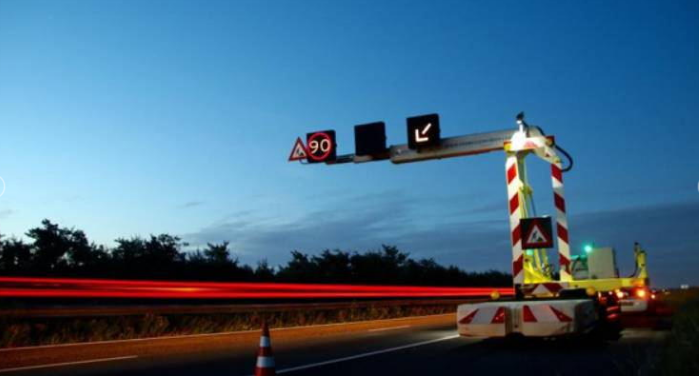Что такое знаки переменной информации на автомагистрали?
Variable Message Signs (VMS), also known as dynamic message signs, electronic message signs, or digital traffic signs, are an essential component of modern highway and roadway management systems. These signs play a crucial role in enhancing traffic safety, improving traffic flow, and providing real-time information to drivers. In this comprehensive exploration, we will delve into the various aspects of Variable Message Signs, their types, functions, benefits, and the technology behind them.
1. Full-Graphic VMS: These signs are the most versatile and can display a wide range of messages, including text, symbols, and simple graphics. Full-graphic VMS are often used to provide detailed information about traffic conditions, such as lane closures, accidents, and weather-related warnings.
2. Text-Only VMS: As the name suggests, these signs display text-based messages. They are commonly used for displaying basic information like speed limits, lane closures, and roadwork ahead.
3. Symbolic VMS: Symbolic VMS use pictograms or icons to convey messages to drivers. They are particularly effective in conveying information to drivers who may not understand the language or have limited literacy skills.
4. Color VMS: These VMS utilize color to convey different types of information. For example, red might indicate a severe traffic problem, while green could signify clear roads ahead.
1. Traffic Management: ВМ are used to manage and control traffic flow by providing real-time information about incidents, congestion, and alternative routes. They help reduce traffic congestion and improve overall traffic management.
2. Safety Warnings: VMS provide immediate warnings to drivers about hazardous conditions, such as accidents, fog, ice, or heavy rain, helping to reduce accidents and improve road safety.
3. Construction and Maintenance Information: When roadwork or maintenance is underway, VMS inform drivers about lane closures, detours, and expected delays, minimizing disruptions and ensuring safety in work zones.
4. Weather Updates: VMS can display weather-related information, such as temperature, visibility, and road conditions, allowing drivers to make informed decisions about their routes and driving conditions.
5. Amber Alerts and Emergency Messages: In cases of emergencies or Amber Alerts, VMS can quickly disseminate critical information to the public, aiding in locating missing persons or responding to other urgent situations.
6. Speed Limit Changes: VMS can dynamically adjust speed limits based on traffic conditions, accidents, or construction zones, ensuring that drivers are aware of the current safe speed.
1. Enhanced Safety: VMS help improve road safety by providing timely warnings about accidents, adverse weather conditions, and other hazards, allowing drivers to take appropriate precautions.
2. Reduced Congestion: By providing real-time traffic information and alternative routes, VMS can help alleviate traffic congestion and reduce travel times.
3. Improved Traffic Flow: VMS assist in managing traffic flow by providing instructions to drivers, such as lane closures or diversions, resulting in smoother traffic operations.
4. Emergency Response: In the event of emergencies, VMS can disseminate critical information quickly, aiding in the coordination of emergency services and evacuation procedures.
5. Environmental Benefits: Reduced congestion and smoother traffic flow contribute to lower fuel consumption and greenhouse gas emissions, benefiting the environment.
6. Cost Savings: Effective traffic management through VMS can lead to cost savings by reducing the need for additional road infrastructure and maintenance.
1. LED Displays: Most modern VMS use Light Emitting Diode (LED) displays for their bright and energy-efficient properties. Технология светодиодных дисплеев allows for the clear and visible display of messages in various lighting conditions.
2. Connectivity: VMS are typically connected to a central Управление дорожным движением system through a network. This connectivity enables real-time updates and remote control of message displays.
3. Sensors and Cameras: VMS often incorporate sensors and cameras along roadways to gather data on traffic conditions and incidents. This data informs the messages displayed on the signs.
4. Central Control Systems: Transportation authorities have centralized control systems that manage the content displayed on VMS. Operators can update messages, change displays, and monitor traffic conditions from a control center.
5. Solar Power and Energy Efficiency: Many VMS are equipped with solar panels to harness renewable energy, reducing their environmental footprint. Energy-efficient components ensure minimal power consumption.
1. Maintenance: VMS require regular maintenance to ensure their reliability. Dust, debris, and harsh weather conditions can affect their visibility and functionality.
2. Visibility and Clutter: In densely populated urban areas, there is a risk of information overload with несколько систем управления видео displaying various messages. Careful placement and message coordination are essential to avoid confusion.
3. Data Accuracy: The effectiveness of VMS relies on accurate and up-to-date data. Inaccurate information can lead to driver confusion and safety hazards.
4. Privacy Concerns: Cameras and sensors used in VMS raise privacy concerns. Striking a balance between data collection for traffic management and privacy protection is crucial.
5. Power Supply: Ensuring a stable power supply, especially in remote areas, can be a logistical challenge.
If you want to know more information about windows, please click on the image below to get a free quote:
Введение в знаки переменных сообщений (VMS)
Знаки переменных сообщений are electronic display boards positioned along highways, expressways, and major roadways to convey important traffic-related information to drivers. Unlike traditional static signs with fixed messages, VMS are highly adaptable, capable of displaying dynamic messages, warnings, and instructions. They are typically mounted on gantries, poles, or other support structures and are equipped with LED or other display technologies that allow for the presentation of text, symbols, and sometimes even simple graphics.Типы знаков переменных сообщений
Variable Message Signs come in various forms, each serving specific purposes:1. Full-Graphic VMS: These signs are the most versatile and can display a wide range of messages, including text, symbols, and simple graphics. Full-graphic VMS are often used to provide detailed information about traffic conditions, such as lane closures, accidents, and weather-related warnings.
2. Text-Only VMS: As the name suggests, these signs display text-based messages. They are commonly used for displaying basic information like speed limits, lane closures, and roadwork ahead.
3. Symbolic VMS: Symbolic VMS use pictograms or icons to convey messages to drivers. They are particularly effective in conveying information to drivers who may not understand the language or have limited literacy skills.
4. Color VMS: These VMS utilize color to convey different types of information. For example, red might indicate a severe traffic problem, while green could signify clear roads ahead.
Функции переменных знаков сообщений
Variable Message Signs serve several vital functions on highways and major roadways:1. Traffic Management: ВМ are used to manage and control traffic flow by providing real-time information about incidents, congestion, and alternative routes. They help reduce traffic congestion and improve overall traffic management.
2. Safety Warnings: VMS provide immediate warnings to drivers about hazardous conditions, such as accidents, fog, ice, or heavy rain, helping to reduce accidents and improve road safety.
3. Construction and Maintenance Information: When roadwork or maintenance is underway, VMS inform drivers about lane closures, detours, and expected delays, minimizing disruptions and ensuring safety in work zones.
4. Weather Updates: VMS can display weather-related information, such as temperature, visibility, and road conditions, allowing drivers to make informed decisions about their routes and driving conditions.
5. Amber Alerts and Emergency Messages: In cases of emergencies or Amber Alerts, VMS can quickly disseminate critical information to the public, aiding in locating missing persons or responding to other urgent situations.
6. Speed Limit Changes: VMS can dynamically adjust speed limits based on traffic conditions, accidents, or construction zones, ensuring that drivers are aware of the current safe speed.
Преимущества вариативных знаков сообщений
The deployment of Variable Message Signs offers several advantages to both transportation authorities and drivers:1. Enhanced Safety: VMS help improve road safety by providing timely warnings about accidents, adverse weather conditions, and other hazards, allowing drivers to take appropriate precautions.
2. Reduced Congestion: By providing real-time traffic information and alternative routes, VMS can help alleviate traffic congestion and reduce travel times.
3. Improved Traffic Flow: VMS assist in managing traffic flow by providing instructions to drivers, such as lane closures or diversions, resulting in smoother traffic operations.
4. Emergency Response: In the event of emergencies, VMS can disseminate critical information quickly, aiding in the coordination of emergency services and evacuation procedures.
5. Environmental Benefits: Reduced congestion and smoother traffic flow contribute to lower fuel consumption and greenhouse gas emissions, benefiting the environment.
6. Cost Savings: Effective traffic management through VMS can lead to cost savings by reducing the need for additional road infrastructure and maintenance.
Технология, лежащая в основе переменных знаков сообщений
The technology used in Variable Message Signs has evolved significantly over the years. Key components of VMS technology include:1. LED Displays: Most modern VMS use Light Emitting Diode (LED) displays for their bright and energy-efficient properties. Технология светодиодных дисплеев allows for the clear and visible display of messages in various lighting conditions.
2. Connectivity: VMS are typically connected to a central Управление дорожным движением system through a network. This connectivity enables real-time updates and remote control of message displays.
3. Sensors and Cameras: VMS often incorporate sensors and cameras along roadways to gather data on traffic conditions and incidents. This data informs the messages displayed on the signs.
4. Central Control Systems: Transportation authorities have centralized control systems that manage the content displayed on VMS. Operators can update messages, change displays, and monitor traffic conditions from a control center.
5. Solar Power and Energy Efficiency: Many VMS are equipped with solar panels to harness renewable energy, reducing their environmental footprint. Energy-efficient components ensure minimal power consumption.
Проблемы и рекомендации
While Variable Message Signs offer significant benefits, they also come with challenges and considerations:1. Maintenance: VMS require regular maintenance to ensure their reliability. Dust, debris, and harsh weather conditions can affect their visibility and functionality.
2. Visibility and Clutter: In densely populated urban areas, there is a risk of information overload with несколько систем управления видео displaying various messages. Careful placement and message coordination are essential to avoid confusion.
3. Data Accuracy: The effectiveness of VMS relies on accurate and up-to-date data. Inaccurate information can lead to driver confusion and safety hazards.
4. Privacy Concerns: Cameras and sensors used in VMS raise privacy concerns. Striking a balance between data collection for traffic management and privacy protection is crucial.
5. Power Supply: Ensuring a stable power supply, especially in remote areas, can be a logistical challenge.
Заключение
Variable Message Signs have become indispensable tools for modern traffic management and road safety. Their ability to provide real-time information, warnings, and instructions to drivers helps reduce congestion, enhance safety, and improve overall traffic flow. With ongoing advancements in technology, VMS will continue to play a pivotal role in optimizing transportation systems and ensuring a safer and more efficient road network for all.If you want to know more information about windows, please click on the image below to get a free quote:









Оставить комментарий